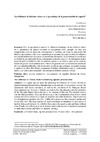Identificador persistente para citar o vincular este elemento:
https://accedacris.ulpgc.es/jspui/handle/10553/72087
| Campo DC | Valor | idioma |
|---|---|---|
| dc.contributor.author | Chen Danna | en_US |
| dc.contributor.author | Wang , Lili | en_US |
| dc.date.accessioned | 2020-05-06T13:51:32Z | - |
| dc.date.available | 2020-05-06T13:51:32Z | - |
| dc.date.issued | 2019 | en_US |
| dc.identifier.issn | 1886-337X | en_US |
| dc.identifier.other | WoS | - |
| dc.identifier.uri | https://accedacris.ulpgc.es/handle/10553/72087 | - |
| dc.description.abstract | Este trabajo pretende mostrar la influencia fonológica de los dialectos chinos en el aprendizaje de español tomando el shanghainés como ejemplo. Se hace una comparación entre el inventario consonántico y vocálico, así como la entonación del dialecto shanghainés y del chino mandarín para encontrar las características fonológicas propias del primero que ayudan en el aprendizaje del español. La investigación revela que se facilita la pronunciación de las consonantes oclusivas sonoras y la entonación menos marcada para los hablantes del shanghainés gracias a su dialecto, pero no les resultan fáciles los grupos consonánticos ni la vibrante. El gran número de consonantes nasales en el chino mandarín dificulta la distinción entre las sílabas que contienen los sonidos nasales y aquellas sin ellos. Por último, se propone el trabajo colaborativo entre el profesorado nativo y no nativo para emprender una enseñanza fonética correcta y eficaz. | en_US |
| dc.description.abstract | This paper aims to show the phonological influence of Chinese dialects in Spanish learning Spanish taking Shanghainese as an example. A comparison between the consonantal and vocalic inventory, as well as the intonation of the Shanghai dialect (Shanghainese) and Mandarin Chinese are made to find the phonological characteristics of the Shanghai dialect that contribute to the learning of Spanish. The research reveals that the Shanghai dialect facilitate the learning of the pronunciation of occlusive voiced consonants and the intonation in Spanish, however, like other Mandarin Chinese speakers, the Shanghainese speakers also find it difficult to pronounce the consonant groups and the alveolar trill. The large number of nasal consonants in Mandarin Chinese makes it hard to distinguish between the syllables that contain the nasal sounds and those without them. Finally, the collaborative work between native and non-native teachers is proposed to undertake a correct and effective phonetic teaching. | en_US |
| dc.language | spa | en_US |
| dc.relation.ispartof | Foro de Profesores De E/LE | en_US |
| dc.source | Foro De Profesores De E-Le [ISSN 1886-337X],v. 15, p. 277-286, (2019) | en_US |
| dc.subject | 570107 Lengua y literatura | en_US |
| dc.subject | 550510 Filología | en_US |
| dc.subject.other | Estudio contrastivo | en_US |
| dc.subject.other | Pronunciación de español | en_US |
| dc.subject.other | Dialecto de China | en_US |
| dc.subject.other | Shanghaines | en_US |
| dc.subject.other | Contrastive study | en_US |
| dc.subject.other | Spanish pronunciation | en_US |
| dc.subject.other | Chinese dialect | en_US |
| dc.subject.other | Shanghainese | en_US |
| dc.title | La influencia de dialectos chinos en el aprendizaje de la pronunciación de español | en_US |
| dc.title.alternative | The influence of Chinese dialects in learning Spanish pronunciation | en_US |
| dc.type | info:eu-repo/semantics/Article | en_US |
| dc.type | Article | en_US |
| dc.identifier.doi | 10.7203/foroele.15.14843 | en_US |
| dc.identifier.isi | 000500930200019 | - |
| dc.description.lastpage | 286 | en_US |
| dc.description.firstpage | 277 | en_US |
| dc.relation.volume | 15 | en_US |
| dc.investigacion | Artes y Humanidades | en_US |
| dc.type2 | Artículo | en_US |
| dc.contributor.daisngid | 31482923 | - |
| dc.contributor.daisngid | 30160811 | - |
| dc.description.numberofpages | 10 | en_US |
| dc.utils.revision | Sí | en_US |
| dc.contributor.wosstandard | WOS:Chen, DN | - |
| dc.contributor.wosstandard | WOS:Wang, LL | - |
| dc.date.coverdate | 2019 | en_US |
| dc.identifier.ulpgc | Sí | es |
| dc.description.esci | ESCI | |
| dc.description.dialnetimpact | 0,0 | |
| dc.description.dialnetq | Q4 | |
| dc.description.dialnetd | D10 | |
| item.grantfulltext | open | - |
| item.fulltext | Con texto completo | - |
| crisitem.author.dept | GIR IATEXT: División de Estudios de Corpus y Lingüística Aplicada | - |
| crisitem.author.dept | IU de Análisis y Aplicaciones Textuales | - |
| crisitem.author.dept | Departamento de Filología Hispánica, Clásica y de Estudios Árabes y Orientales | - |
| crisitem.author.orcid | 0000-0003-0478-5784 | - |
| crisitem.author.parentorg | IU de Análisis y Aplicaciones Textuales | - |
| crisitem.author.fullName | Wang, Lili | - |
| Colección: | Artículos | |
Visitas
299
actualizado el 29-mar-2025
Descargas
215
actualizado el 29-mar-2025
Google ScholarTM
Verifica
Altmetric
Comparte
Exporta metadatos
Los elementos en ULPGC accedaCRIS están protegidos por derechos de autor con todos los derechos reservados, a menos que se indique lo contrario.
